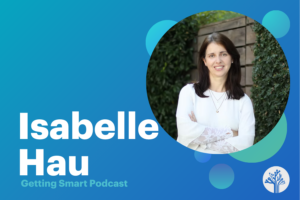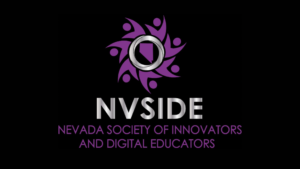The Classroom & Learning in 5 Years: Impossible to Envision?

Honestly, one of my favorite, yearly activities at the ISTE Conference involves touring the enormous Expo Center of educational vendors. I don’t know the exact size of this ground-level area of Atlanta’s World Congress Center, but the word “gargantuan” doesn’t suffice. With each random step, my eyes dart back and forth like an owl on speed looking through a kaleidoscope. But make no mistake about it. My New Balance-cushioned pace has a purpose. Every stride, every inquisitive look, every piece of educational bling-bling has me pondering, “What will the classroom and learning look like in five years?”
Ironically enough, however, sitting on my rear and getting off my feet at the ISTE Conference always gets me closer to any semblance of an answer. Why? Because the power of attending this conference can best be distilled in one word…conversation. Whether it occurs during hacked education, hallway gatherings, formal keynote addresses, twitter chats, workshops, interactive sessions, or escalator conversations that carry upward and morph into one-to-one hallway chats, thoughtful articulation of educational ideas reigns supreme when envisioning the learning environment of the future. I mean, after all, we need to know where we are headed so we can get there. Right?
As Dave Guymon recently reminded us, “process over product prevails,” and during a recent panel discussion, “School 2.0: Where Are We Headed,” this fact became further ingrained in my teacher’s heart. Led by Steve Hargadon, a panel of brilliant educators (Lucy Gray, Julie Lindsay, Dr. Gary Stager, and Alice Keeler) invoked a conversation that serves as the trailhead of foresight when contemplating the future of classrooms and learning.
Perhaps Julie Lindsay highlighted one of the most vital clues when she said students need to be empowered and teachers and administrators need to release the control. While reminding the audience that the lesson, and not the technology, is the focus, Alice Keeler stated her position by alluding to some educators who have merely transferred their trusted reams of worksheets to iPads.
Moves like these are not nudging our educational system towards establishing the classrooms of the future that need to be a reality now.
Clearly the result of teachers and administrators relinquishing control would be creativity and engagement, and the presence of these two characteristics will pave the way for constructing our future classrooms.
In fact, when asked at the session’s conclusion to describe their visions of the classroom as it will appear in five years, the following extemporaneous and thought-provoking comments flowed from the following two panelists and one audience member:
Steve Hargadon
“I think that’s going to depend on what we really believe about students. So, if we believe that it’s important for them to be independent, that every one of them has individual worth and value, then we will create classroom environments that reflect that commitment to every student. If we believe that they are machines, and that we give them inputs and expect to get things in return, then we will have very structured, conformist classrooms. So, we really have to decide what we believe.”
Julie Lindsay
“Technology is ubiquitous. You don’t see the technology. We need to look at designing learning experiences that include online as well as offline. It needs to be very carefully designed, and a shift in pedagogy [needs to take place] that allows for student-based learning experiences.”
Becky Hare
“We are on the way. We are talking personalized pathways that kids are choosing. Personal choice. Empower. You can use the word empower, unless they are not choosing and empowering themselves in a passion-based learning model. And it doesn’t have to be passion-based for 20% or passion hour or…it just needs to be passion….based… stuff.”
My inquisitive chats extended beyond the session hours later when I and several colleagues from my district continued to brainstorm. Penny Christensen, a blending learning specialist and extremely passionate educator, said, “Where is education heading? Maybe it is heading back to the classroom and back to the teacher. I think the impact of the big organizations like think tanks, the Department of Education, and school districts will always be monetarily funded, but this funding will be less important than the autonomy each teacher exercises in his/her own room. As the profession flattens and teachers can reach out to anyone and everyone, educational resources won’t only flow from those big organizations anymore. Ideas and energy will stem from any place. People leave teaching because they run low on emotional funding, not monetary funding.”
What will the classroom look like in five years? I have no idea.
@JohnHardison1 The word “classroom” will be completely obsolete. “Classroom” makes me think of compartmentalized, disparate learning.
— Danica Pruitt (@crayonkeepin) July 1, 2014
@JohnHardison1 #futureclass #edchat #edtech #ISTE2014 no classes, individual student tracts- advisors (teachers) guiding paths to learning — Teri Lance (@LancelotTeacher) July 1, 2014
@JohnHardison1 I hope #futureclass looks like whatever students need it to. Free and flowing with creativity! #ISTE2014
— Greg Odell (@ugaodawg) July 1, 2014
I know one thing is for sure, it is a 24-7-365 job to even attempt to stay ahead of all the educational possibilities that forward thinking and technology are creating every second. But I do know it does not begin with an infinite amount of square footage filled to the rim with technology gadgets and software. Those are just resources. The answer lies somewhere else. Somewhere, perhaps, embedded in the following opinion from Dr. Gary Stager:
“There are 2 options for the future. A classroom can be a wondrous place where kids wake up in the middle of the night and can’t wait to get back to school to return to some project they’re working on that makes meaning and excites them and demonstrates their competence and curiosity and creativity OR the classroom can look exactly as it does today…but there just won’t be any children in it.”
Hmmm. That gets me thinking. “Steve Hargadon’s panel discussion, ‘School 2.0,’ should have been housed in the Expo Center.”
Well, on second thought…there probably wouldn’t have been enough room with all the teachers attending.
(Care to share your vision of what learning and the modern “classroom” will look like in just five years? Please leave a comment here or use the hashtag #ClassFinity on Twitter and include @JohnHardison1. Let’s continue this riveting and inexhaustible conversation.)







0 Comments
Leave a Comment
Your email address will not be published. All fields are required.